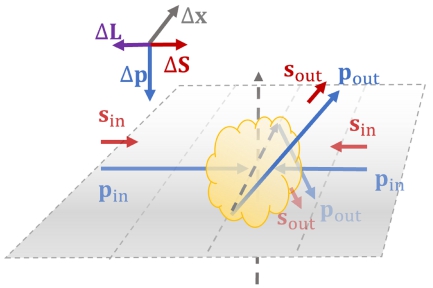Researchers Develop First Angular Momentum Conserved Transport Model for Ultra-relativistic Many-body Systems
Transport model is an important theoretical tool used in non-equilibrium many-body systems to describe the evolution of particles’ microscopic states such as momentum, position and spin. Boltzmann and Langevin equations are two famous examples widely used in condensed matter physics and nuclear physics.
Conservation laws play essential roles in transport models. The energy-momentum conservation could be realized in most transport models so that they could approach equilibrium limit. However, the conservation of the angular momentum, an essential ingredient in spin physics, has rarely been studied and implemented in transport models.
Dr. LIU Shuai at Quark Matter Research Center, Institute of Modern Physics (IMP) of the Chinese Academy of Sciences, together with researchers at Texas A&M University and Laboratori Nazionali del Sud, have developed the first angular momentum conserved transport model for ultra-relativistic many-body systems and applied it to study the spin physics in heavy-ion collisions.
To achieve the angular momentum conservation in the transport model, the researchers introduced a novel side-jump effect, which was first proposed in the study of the anomalous hall effect in condensed matter physics.
In a scattering with the side-jump effect, particles not only change the momenta but also make a jump in coordinate space to the direction perpendicular to the total momentum. This side-jump effect during the collisions is a manifestation of the nontrivial Lorentz transform of the position of the particle with spins, which requires an additional side-jump to the usual Lorentz transformation.
With this side-jump Lorentz transformation, the researchers have constructed the first transport model that not only conserves the angular momentum but also satisfies the requirement of covariance.
Furthermore, the researchers applied the model to study spin polarizations in relativistic heavy-ion collisions for Au-Au collisions, where the experiments were conducted at the Relativistic Heavy Ion Collider (RHIC) at the Long Island of New York. By studying the dynamics of the spin of quarks, the researchers found promising features and unique insights toward solving the spin puzzles for local polarization of Lambda baryon, which has bothered the community for several years.
The work was published in physical review letters recently.
Link to the article: https://journals.aps.org/prl/abstract/10.1103/PhysRevLett.125.062301

Angular momentum conserved side jump collision of the chiral particle. (Image by LIU Shuai)


 甘公网安备 62010202000713号
甘公网安备 62010202000713号


